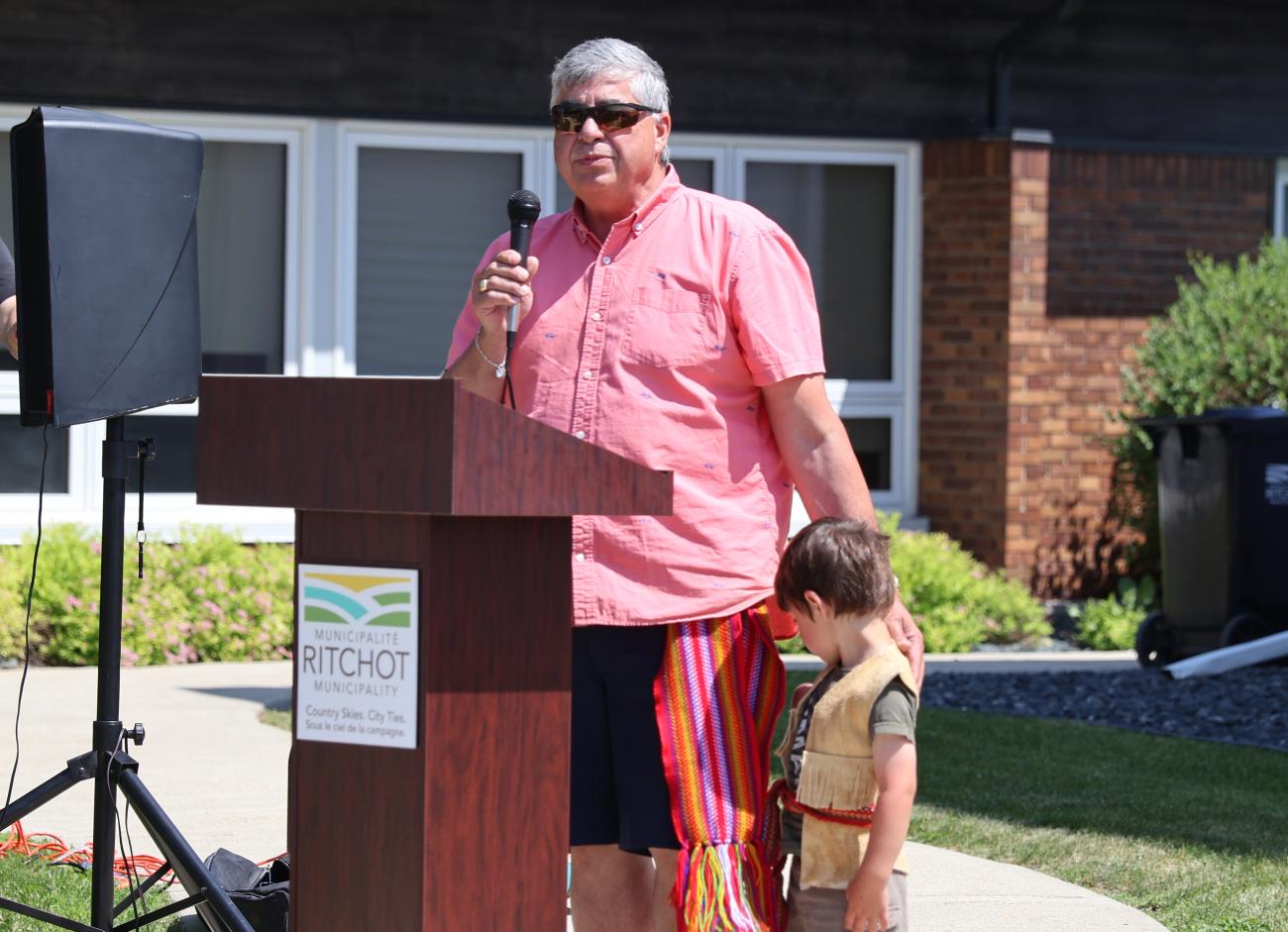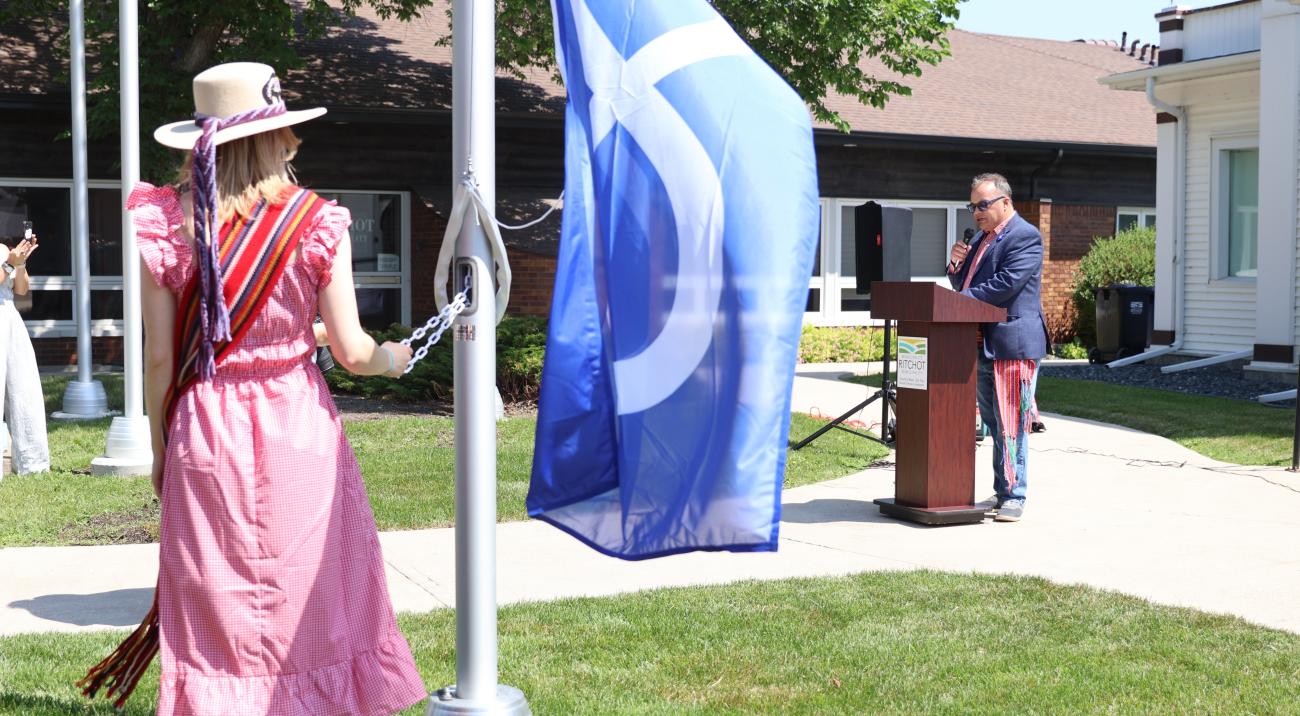On June 21, festivities took place across the country in celebration of National Indigenous Peoples Day.
This year, St. Adolphe played host to its first such celebration, organized by the Manitoba Metis Federation (MMF) Southeast Region St. Adolphe Local (SRSAL) and the Friendship Trail committee.
Held on the grounds of the Ritchot civic office, the local celebration reflected on the deep Metis roots of the region while, at the same time, providing the ideal opportunity to officially unveil the town’s newly installed Red River Metis cart.
Deputy Mayor Shane Pelletier officiated the ceremony while his daughter Zoe, secretary of the SRSAL, raised the Metis flag.
Janessa Roy, volunteer with Moon Time Connections, danced a traditional Red River jig (see video below) and The Wagons performed from the main stage in the afternoon.
Pelletier regaled the gathered crowd with a bit of local Metis history, beginning with Grande Pointe.
“The small but vibrant community was home to a mix of French, European, and English families,” Pelletier said. “Life centred around the Seine River until the construction of the Pembina Branch Railway in 1874, which brought new opportunities and growth. Many locals helped build the railway, and soon after a train station and stockyard were added.”
St. Adolphe, then known as Pointe Coupèe, was founded by the Metis in the early 1800s. They played a significant role in the 1869 Metis Resistance.
“When a survey crew arrived in defiance of a Metis land claim, the community stood firm, removing survey stakes, burning supplies and defending their rights,” Pelletier continued.
Pointe à Grouette was the early name of Ste. Agathe. Here, Metis once settled along the riverbank, enjoying the area for its wealth of resources.
“They were skilled buffalo hunters, freighters, and farmers, and they even operated a salt-making enterprise. The area was rich in culture and community spirit.”
According to Pelletier, the Red River cart was an essential part of Metis life, used to transport goods, families, and tools across great distances. These carts made a distinctive high-pitched squeal that could be heard for miles around.
Eventually, the sound became synonymous with the movement and presence of the Metis people.
“The cart carried more than just goods,” Pelletier said. “It carried family, it carried resistance and resilience. As we place this cart beside our municipal office, we recognize that the Metis story is not just a part of our past, it is alive in the foundations of our region and community today.”
MMF Minister Shawn Nault also took to the podium that afternoon. The blue Metis flag, he explained, was first flown on June 19, 1816.
The infinity symbol emblazoned on the flag bears a dual meaning. First, it represents the continual flow of Red River cart wheels in the nineteenth century.
As well, it’s indicative of the ongoing Metis bloodline, passed from generation to generation.
“It has taken 150 years for us to get the recognition and some of the respect that should have been given to us long ago, but now it is happening,” Nault said.
According to Nault, the Metis peoples were granted self-governance by the federal government via the MMF on June 6, 2021.

Andrew Carriere, acting vice president of the Manitoba Metis Federation, addresses the crowd.
Andrew Carriere is the acting vice president of the MMF. He, too, addressed the crowd.
Recently, he said, the federal government granted $15 million to the MMF to assist them in promoting, preserving, and teaching the Michif language to Metis children. The Michif language is a combination of French, Cree, and Ojibway and was all but lost during the residential school years.
Carriere and his descendants have lived in this region for the past 500 years. The Metis originally covered an area from northwestern Ontario to the mountains of Alberta and from Churchill down to North Dakota.
“In 1970, there was a big battle where the English tried to get rid of the French Metis,” Carriere later told The Citizen. “As a matter of fact, there was a time when the European thought of the Indigenous people as animals without a soul, so there was an actual hunt [to get rid of us].”
Indigenous Peoples Day celebrations, he says, are helping to restore a sense of pride after decades of repression. Despite their mix of cultures, they enjoy a language, dance, music, and traditional practices that are distinctly theirs.
The traditional Metis sash, Carriere adds, has significance that is similar to the Scottish tartan in that the colours and design represent a specific family clan.
Attendees to the Saturday event were invited to apply for their Metis citizenship. Carriere says there are approximately 200,000 residents of Manitoba who would qualify for Metis status.
In order to qualify, an individual must have record of original Metis descendants hailing from this region. The St. Boniface Genealogy Society can help track family history to determine that.
Once members of the MMF, residents can take advantage of subsidies on prescription drugs and funeral expenses for seniors, tuition and book subsidies for students, and daycare and homebuyers’ subsidies for families.
As well, they can enjoy special hunting and fishing benefits.


